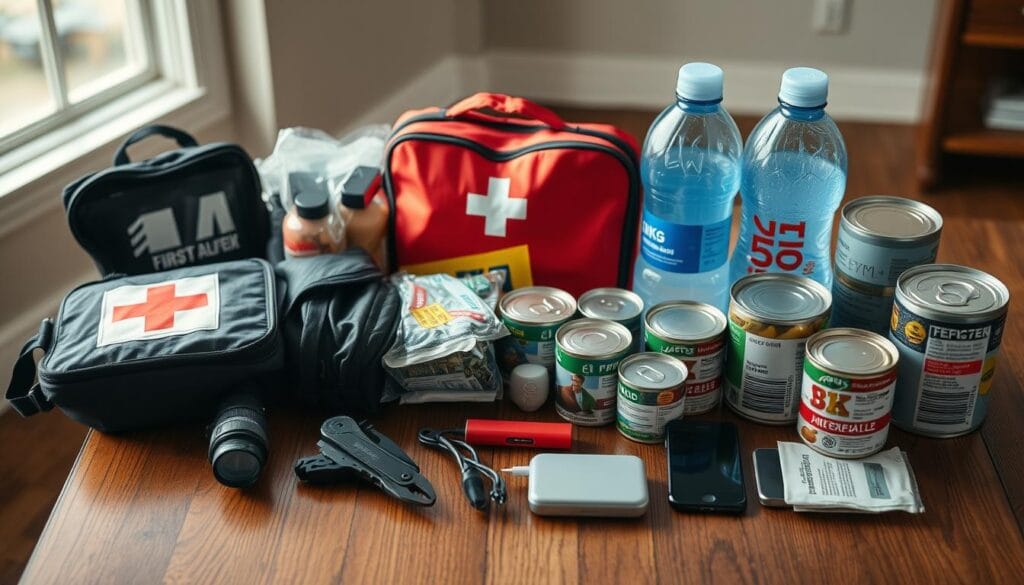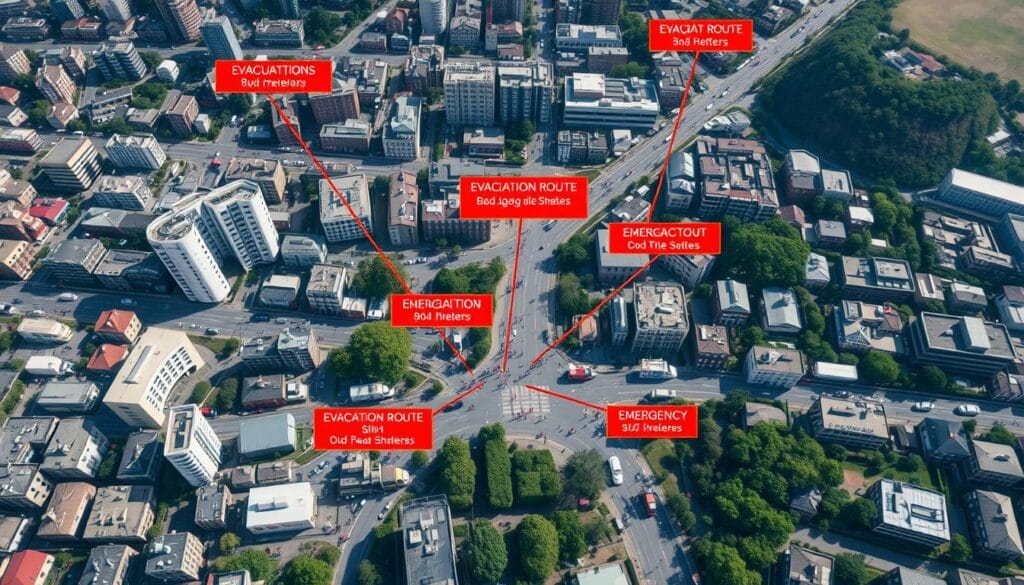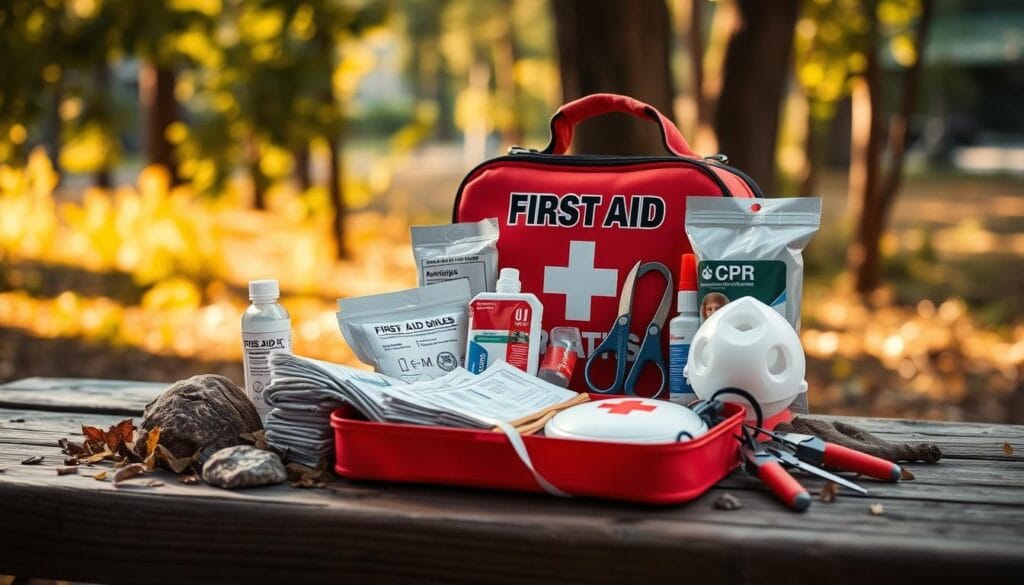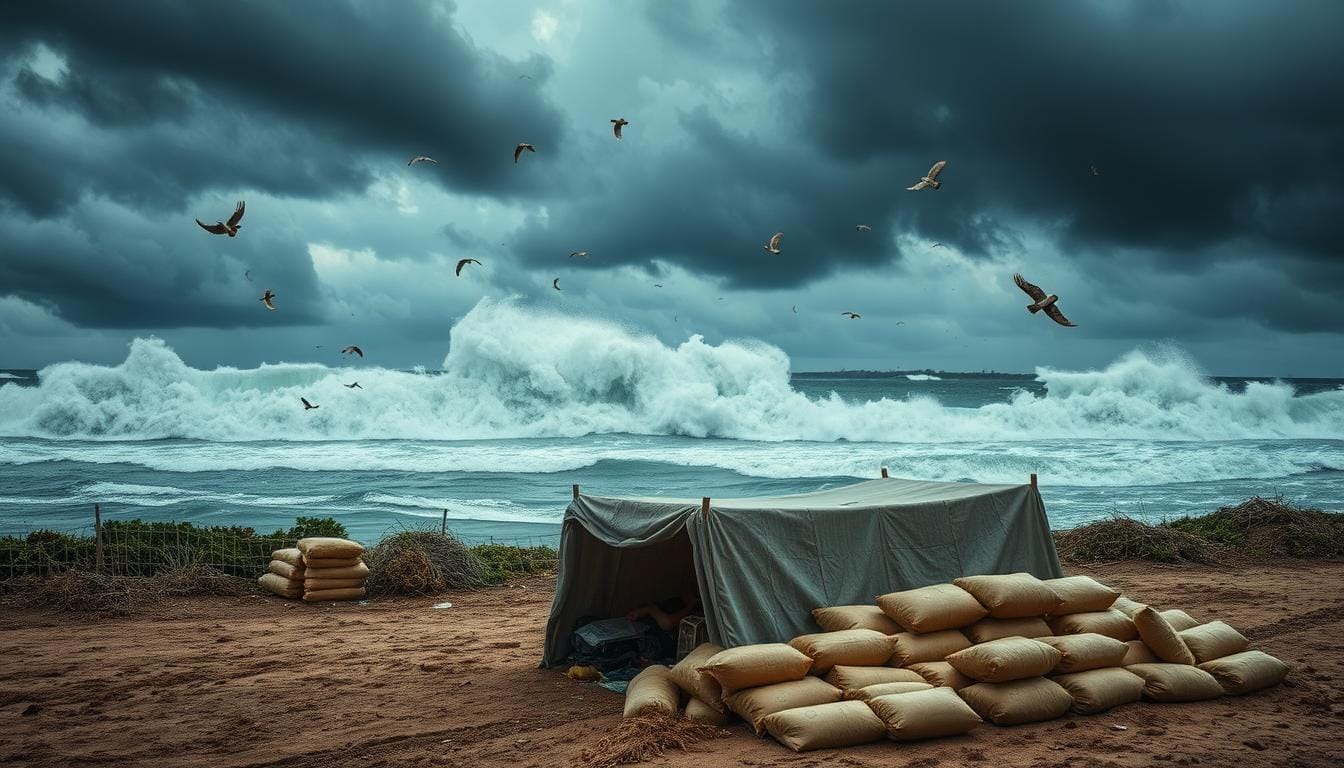In today’s world, natural disasters can strike without warning, disrupting lives and causing widespread devastation. However, with the right knowledge and preparation, you can increase your chances of survival and minimize the impact of these events. This comprehensive guide provides essential information and actionable tips to help you and your loved ones prepare for and survive natural disasters.
Key Takeaways
- Understand the different types of natural disasters and their potential impacts
- Develop an emergency plan and assemble a comprehensive emergency kit
- Learn essential survival skills and techniques for navigating natural disasters
- Secure your home and property to minimize damage and increase resilience
- Prioritize your mental and physical well-being during and after a natural disaster
Understanding Natural Disasters
Natural disasters are unpredictable and can have devastating consequences. From hurricanes and tornadoes to earthquakes and wildfires, these natural hazards pose significant threats to communities around the world. Understanding the different types of natural disasters and their potential impacts is crucial for developing effective preparedness strategies.
Types of Natural Disasters
There are several major types of natural disasters that can occur, including:
- Hurricanes and tropical storms
- Tornadoes and severe thunderstorms
- Earthquakes and volcanic eruptions
- Wildfires and droughts
- Floods and landslides
Each of these natural disasters has unique characteristics and can cause a wide range of damage, from property destruction to loss of life. Preparing for these events requires a comprehensive understanding of the risks and potential impacts.
Potential Impacts and Risks
Natural disasters can have far-reaching consequences, affecting both individuals and communities. Some of the potential impacts and risks associated with these events include:
- Damage to homes, businesses, and critical infrastructure
- Disruption of essential services, such as power, water, and transportation
- Displacement of people and mass evacuations
- Injuries and loss of life
- Long-term economic and environmental damage
Understanding these potential impacts is crucial for developing effective preparedness and response strategies to mitigate the risks and protect communities in the face of natural disasters.
“Natural disasters are inevitable, but with proper preparation and response, we can minimize their devastating impact on our communities.”
Developing an Emergency Plan
Crafting a comprehensive emergency plan is a crucial step in disaster preparedness. This plan should outline the steps your family will take to ensure your safety in the event of a natural disaster. Building an emergency kit with essential supplies is a vital component of your emergency plan.
Essential Items for Emergency Kits
When assembling your emergency kit, focus on including items that will sustain you and your family during a crisis. Some essential survival supplies to consider include:
- Non-perishable food and water (at least one gallon per person per day for at least three days)
- Flashlights, batteries, and a hand-cranked or solar-powered radio
- First aid kit, medications, and personal hygiene items
- Warm clothing, blankets, and sturdy shoes
- Cash, important documents, and copies of identification
- Tools for emergency repairs, such as a wrench, pliers, and duct tape
It’s also essential to regularly review and update your emergency kit to ensure it remains well-stocked and ready for use. By taking the time to develop a comprehensive emergency plan and assemble a well-equipped emergency kit, you can increase your family’s chances of safely weathering a natural disaster.

Natural Disaster Survival Tips
When faced with a natural disaster, your survival skills can make all the difference. By following these practical tips, you can increase your chances of staying safe and weathering the storm.
Finding Secure Shelter
Seek out sturdy, well-constructed buildings that can provide shelter from the elements. Avoid areas prone to flooding, landslides, or other hazards. If you’re caught outside, look for low-lying areas or depressions that can offer protection.
Staying Hydrated and Nourished
Maintain a supply of clean, potable water and non-perishable, high-calorie foods. Avoid consuming contaminated water or spoiled food, which can lead to illness. Conserve your resources and ration them accordingly.
Communication and Connectivity
Keep a charged, battery-powered device on hand to stay connected with emergency services and loved ones. Familiarize yourself with local emergency communication channels and be prepared to relay your location and situation if necessary.
Protecting Yourself and Your Loved Ones
- Wear protective clothing, such as sturdy shoes, long pants, and a hat, to shield yourself from potential hazards.
- Maintain a first-aid kit and basic medical supplies to treat minor injuries or illnesses.
- Be aware of your surroundings and take immediate action to seek safety if conditions worsen.
Remember, the key to natural disaster Survival Skills is preparation, adaptability, and a calm, level-headed approach. By following these tips, you can increase your chances of weathering the storm and emerging safely on the other side.
“The greater the disaster, the more necessary it is to remain calm and focused.”
Evacuation Strategies and Procedures
When natural disasters strike, having a well-planned evacuation strategy can make all the difference in ensuring your safety. Evacuation planning is a crucial aspect of disaster preparedness, as it helps you and your family swiftly navigate to safety when the need arises.
Evacuation Routes and Shelters
One of the key components of an effective evacuation plan is identifying the safest and most accessible evacuation routes. These routes should be mapped out in advance, taking into account potential obstacles, road closures, and alternative options. Additionally, it’s essential to locate the nearest emergency shelters that can provide temporary refuge during a natural disaster.
- Research and familiarize yourself with the designated Evacuation Planning routes in your area.
- Identify the closest Emergency Shelters that can accommodate you and your family during a Disaster Evacuation.
- Stay informed about any updates or changes to evacuation plans and shelter locations through local emergency management authorities.
Regular practice drills can help ensure that your family is prepared to execute the evacuation plan swiftly and efficiently when the need arises. By taking the time to plan and prepare, you can increase your chances of reaching safety during a natural disaster.

“Being prepared for a natural disaster can mean the difference between life and death. Evacuation planning is a critical component of that preparedness.”
Navigating the challenges of a natural disaster can be daunting, but with the right strategies and procedures in place, you can increase your chances of survival and ensure the safety of your loved ones.
First Aid and Medical Preparedness
In times of natural disasters, having a solid understanding of first aid and being medically prepared can be the difference between life and death. Equipping yourself with essential emergency medical care knowledge and supplies is a crucial aspect of disaster preparedness.
Basic First Aid Skills
Mastering basic first aid techniques is crucial for effectively responding to injuries and medical emergencies during a natural disaster. These essential skills include:
- Wound care and bandaging
- CPR and rescue breathing
- Controlling bleeding
- Treating burns, sprains, and fractures
- Identifying and managing shock
By learning and practicing these first aid techniques, you can be better prepared to provide immediate and potentially life-saving assistance in the event of an emergency.

“The most important first aid skill is being prepared with the right knowledge and supplies before a disaster strikes.” – Dr. Jane Doe, Emergency Medicine Specialist
In addition to basic first aid skills, it is crucial to assemble a well-stocked emergency medical kit that includes essential items such as bandages, antiseptic wipes, pain relievers, and any necessary personal medications. Having these supplies on hand can greatly improve your ability to respond effectively to medical emergencies during a natural disaster.
By prioritizing first aid and medical preparedness, you can increase your chances of survival and provide valuable assistance to those in need during a natural disaster emergency.
Securing Your Home and Property
Protecting your home and valuable possessions is a critical aspect of natural disaster preparedness. As natural disasters like hurricanes, earthquakes, and wildfires threaten communities, it’s essential to take proactive steps to safeguard your property and ensure the safety of your family. This section will explore practical strategies for home preparedness, property protection, and disaster mitigation.
Reinforcing Your Home’s Structure
One of the most effective ways to secure your home is to strengthen its structural integrity. This can involve reinforcing the roof, walls, and foundation to withstand the powerful forces of nature. Consider consulting a professional contractor or engineer to assess your home’s vulnerabilities and recommend the appropriate reinforcement measures.
Protecting Windows and Doors
Windows and doors are particularly vulnerable during natural disasters. Install impact-resistant windows and doors, or consider installing storm shutters or plywood coverings to protect against shattering. Ensure that all entry points are properly sealed and secured to prevent water intrusion and wind damage.
Safeguarding Valuable Possessions
In addition to securing your home’s structure, it’s important to take steps to protect your valuable possessions. Create an inventory of your most important items, such as important documents, family heirlooms, and electronics, and store them in a secure, waterproof container or safe. Consider storing these items in a safe deposit box or an off-site location for added protection.
“Preparing your home and property for natural disasters is not only about protecting your physical assets, but also about providing a sense of security and peace of mind for you and your loved ones.” – Jane Doe, Disaster Preparedness Expert

By implementing these home preparedness, property protection, and disaster mitigation strategies, you can significantly reduce the risk of damage to your home and belongings in the event of a natural disaster. Remember, the time to prepare is before the crisis strikes, so take action today to safeguard your property and ensure the well-being of your family.
Natural Disaster Survival
In the face of a natural disaster, your survival skills and preparedness are crucial. Whether you’re weathering a flash flood, tornado, or earthquake, understanding the appropriate disaster response can mean the difference between life and death. By mastering essential techniques, you can increase your chances of making it through an emergency situation safely.
One of the primary concerns during a natural disaster is access to clean water and food. Natural Disaster Survival emphasizes the importance of having a reliable water source and non-perishable snacks readily available. Proper hydration and nourishment can sustain you until help arrives or you can safely evacuate the area.
- Locate and purify water sources, such as streams or rain collection systems.
- Pack high-calorie, long-lasting foods like granola bars, dried fruits, and nuts.
- Learn signaling techniques to attract the attention of rescue teams.
In addition to securing basic necessities, it’s crucial to have a plan for disaster response and emergency situations. Familiarize yourself with evacuation routes, seek shelter in safe structures, and be prepared to administer first aid if needed. By staying calm and taking decisive action, you can increase your chances of weathering the storm and emerging unscathed.
| Survival Skill | Description | Importance |
|---|---|---|
| Water Purification | Techniques to make contaminated water safe for consumption | Ensures access to clean, potable water during a disaster |
| Fire Starting | Methods to ignite a fire for warmth, cooking, and signaling | Provides heat, light, and the ability to signal for help |
| Shelter Building | Constructing temporary shelters from available materials | Protects against the elements and provides a safe space |
By mastering these survival skills and maintaining a level head, you can increase your chances of emerging from a natural disaster unscathed. Remember, preparation and knowledge are your greatest allies in the face of unpredictable environmental threats.
Psychological Preparedness and Coping Mechanisms
When facing a natural disaster, the emotional and psychological impact can be just as overwhelming as the physical challenges. Maintaining mental well-being, managing stress and anxiety, and building resilience are crucial for weathering the storm.
Managing Stress and Anxiety
Preparing for the psychological aspects of a natural disaster can help alleviate the burden during and after the event. Psychological preparedness involves developing coping strategies to manage stress and anxiety. By proactively addressing these mental health concerns, individuals can enhance their disaster coping abilities and emerge more resilient.
- Practice relaxation techniques such as deep breathing, meditation, or yoga to calm the mind and body.
- Establish a support network of family, friends, or community members to share experiences and seek emotional comfort.
- Limit exposure to distressing media coverage and focus on factual information from reliable sources.
- Engage in self-care activities, such as exercising, getting adequate rest, and maintaining a healthy diet, to maintain physical and mental well-being.
By prioritizing psychological preparedness, individuals can navigate the challenges of a natural disaster with greater resilience and emotional stability.
| Coping Strategy | Benefits |
|---|---|
| Mindfulness Practices | Reduce stress and anxiety, improve emotional regulation |
| Social Support | Provide comfort, share experiences, and foster a sense of community |
| Self-Care Routines | Maintain physical and mental well-being, enhance overall resilience |
By integrating these proven strategies into their disaster preparedness plans, individuals can cultivate the mental and emotional resources needed to navigate the challenges ahead.
Disaster Recovery and Rebuilding
In the aftermath of a natural disaster, the road to recovery and rebuilding can be arduous, but with the right guidance and resources, it is possible to restore your home and community. This section will explore the critical steps involved in navigating the insurance claims process and accessing financial assistance to support your rebuilding efforts.
Insurance Claims and Financial Assistance
One of the first and most crucial steps in the disaster recovery process is filing an insurance claim. This can be a complex and often overwhelming task, but it is essential to ensure you receive the necessary funds to rebuild your home or business. To maximize your chances of a successful claim, it is important to thoroughly document the damage, communicate with your insurance provider, and be persistent in following up on the claim.
In addition to insurance claims, various forms of financial assistance may be available to aid in the recovery and rebuilding process. This can include government-provided disaster relief funds, low-interest loans, and grant programs. Researching and applying for these resources can be a time-consuming but worthwhile effort, as they can provide much-needed financial support during this challenging time.
| Financial Assistance Options | Eligibility Criteria | Application Process |
|---|---|---|
| Federal Emergency Management Agency (FEMA) Assistance | Residents of federally-declared disaster areas | Online, by phone, or in-person at a disaster recovery center |
| Small Business Administration (SBA) Disaster Loans | Small businesses, homeowners, and renters affected by a disaster | Online or by visiting a disaster recovery center |
| State and Local Disaster Relief Funds | Varies by location and program | Typically through state or local government websites or offices |
By understanding the available financial resources and navigating the claims process, individuals and communities can take crucial steps towards rebuilding and recovering from the devastating impacts of natural disasters.
Community Preparedness and Response
When natural disasters strike, communities must come together to ensure the safety and resilience of their neighborhoods. Community preparedness is essential in minimizing the impact of these events and supporting those in need.
Neighborhood Watch and Support Systems
Establishing a robust neighborhood watch program can be a vital component of disaster response and community preparedness. These programs encourage residents to stay vigilant, report suspicious activities, and work collaboratively with local authorities to enhance overall neighborhood resilience.
In addition to neighborhood watch initiatives, communities can also develop support systems to assist one another during and after natural disasters. This may include:
- Organizing emergency supply distribution centers
- Coordinating volunteer efforts for cleanup and recovery
- Providing temporary shelter and housing for displaced residents
- Offering mental health and counseling services to address trauma
By fostering a sense of community and collaboration, these support systems can help individuals and families navigate the challenges posed by natural disasters with greater resilience and unity.
“Disaster resilience is not just about individual preparedness, but about the strength of our communities to come together and support one another in times of crisis.”
Strengthening community preparedness and disaster response capabilities at the neighborhood level is crucial for enhancing the overall resilience of a community. By working together, residents can better protect their homes, families, and communities in the face of natural disasters.
Technology and Resources for Disaster Preparedness
In today’s digital age, Disaster Preparedness Technology has become an invaluable tool for individuals and communities when it comes to natural disaster preparedness and response. From real-time alerts to emergency resources, a wide range of Emergency Resources and Disaster Apps are available to help you stay informed, connected, and ready for any natural calamity.
One of the most essential Disaster Preparedness Technology tools is early warning systems. Apps like FEMA and Red Cross allow users to receive timely alerts for potential disasters in their area, giving them the opportunity to take necessary precautions and actions. These Disaster Apps can also provide critical information on evacuation routes, emergency shelters, and relief efforts.
Beyond alerts, Emergency Resources available online and through mobile apps can help you build a comprehensive emergency kit, access medical guidance, and even locate loved ones in the event of a disaster. Apps like Zello and Nextdoor facilitate communication and community support, allowing you to stay connected with your network during times of crisis.
| Disaster Preparedness Technology | Description | Key Features |
|---|---|---|
| FEMA Mobile App | Official disaster response and recovery app from the Federal Emergency Management Agency (FEMA) |
|
| Red Cross Emergency App | Comprehensive emergency preparedness and response app from the American Red Cross |
|
| Zello Walkie Talkie | Push-to-talk communication app that enables real-time connection during emergencies |
|
By leveraging the power of Disaster Preparedness Technology, you can stay informed, connected, and equipped to handle natural disasters effectively. Explore the wide range of Emergency Resources and Disaster Apps available to ensure your safety and well-being in times of crisis.
Disaster Mitigation Strategies
Proactive disaster mitigation strategies play a crucial role in reducing the impact of natural hazards and building more resilient communities. One key approach is environmental protection, which involves preserving and restoring natural ecosystems that can act as barriers against various natural disasters.
Environmental Protection and Sustainability
Sustainable practices, such as reforestation, coastal wetland restoration, and the construction of green infrastructure, can enhance a region’s ability to withstand the consequences of natural disasters. These efforts not only mitigate the direct effects of hazards but also contribute to long-term sustainability and environmental conservation.
Additionally, implementing measures to improve energy efficiency, promote renewable energy sources, and reduce greenhouse gas emissions can help address the underlying causes of climate change, which is exacerbating the frequency and intensity of natural disasters. By adopting sustainable practices, communities can build greater resilience and minimize the risks posed by natural hazards.
